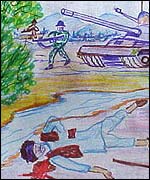English 2F - Children's Literature Module 6: Contemporary Realism and Sociocultural Theory |
|
Unlike fantasy and fairy tales, which illuminate the essential qualities and concerns of being human by presenting figures that are larger than life, realistic children's literature reflects characters and situations that are common, and that the child (and adult) reader would recognize from their own lives or the lives of those they care about. Often, realistic fiction unflinchingly depicts children in crisis, experiencing the full range of human problems and emotions from many perspectives, in a way that allows children to relate intimately to the characters and situations presented. |
artwork by an Afghan war orphan |
Some Common Themes in Modern Realism |
||||
Death Disease War Divorce |
Sexuality Mental Illness Friendships Sibling Rivalry |
Oppression Abandonment Violence Racism |
Poverty Bullying Disability Abuse/Neglect |
Maturation Survival Competition |
One strategy for interpreting realistic fiction: Sociological or Cultural Theory Sociological or Cultural theorists believe that art is a way of making a political statement, and that an examination of a text will reveal some of the social, economic and political structures of a particular culture, or beliefs of a particular author or set of readers. If you interpret a text based on these theories, you would look at the way power is represented, and the power imbalances that result when one group has more power than another. From this examination, you might begin to uncover more of the hidden messages being sent to, or interpreted by, the reader. There are several types of socio-cultural theory: Feminist theory - concerns itself with the representation in literature of "masculine" and "feminine", and with the social and cultural implications of these representations. A feminist critic examines a text for themes about gender and sex, including gender and sex roles, ideals of masculinity and femininity, and rebellion against or acceptance of these ideals and roles. Marxist theory - argues that language can be a tool by which members of one class can hold power over others. A Marxist critic examines texts for themes of social justice, class structure, and the unequal distribution of resources and social status, among others. Race Theory - examines representations of race and/or ethnicity in a text, and with the social and cultural implications of these representations. A race theorist will examine texts for racial stereotypes, themes of ineqalities based on race or ethnicity, and racial identity and affiliation. Queer Theory - examines the representation of sexual orientation in a text, and with the social and cultural implications of these representations. A queer theorist will examine a text for themes of heterosexual privelege, sexual identity and affiliation, homoerotic imagery (either latent or articulated) and power imbalances based on sexual orientation. Colonial Theory - concerns itself with power imbalances caused by one culture subverting or dominating another. Examines a text to reveal themes of culture clash, political power and cultural stereotypes, among others. |
|
If we begin to analyze a text using one of the theories listed above, we will focus on how the author portrays the imbalances of power, and the implicit or explicit political statement that an author makes via the characters and plot of the story. For example, if an author depicts traditional gender roles in the story, without questioning the expectations and assumptions that go along with traditional gender roles, and the power imbalance those expectations and assumptions engender, a reader might assume that the author has no problem with these traditional gender roles and no wish to challenge them. On the other hand, the author might overtly challenge the traditional cultural models of femininity and masculinity. |
|
| Awareness of audience: When thinking about sociocultural theory, it's important to look at when and where the text was published, and the cultural values that would have shaped not just the author, but the author's original, or intended audience. A careful analysis of any text must include an exploration of how the text might have affected the original audience, and how a more modern audience might react differently to the power imbalances presented. |
